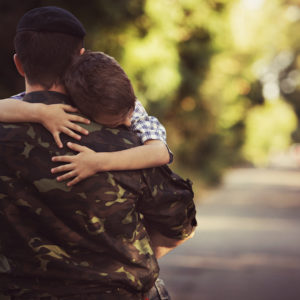Students with at least one parent serving in the U.S. military will move an average six to nine times between kindergarten and graduating high school.
A new report from The Lexington Institute promotes best practices from schools and districts with large military populations to help other administrators as they develop student information systems in compliance with a federal education law. The Every Student Succeeds Act creates a new student subgroup for military-connected students and requires all public school districts to use a Military Student Identifier to track those students. Officials caution that students will not be individually identified. Rather, the identifier should help as students transition in and out schools, making those moves as seamless as possible.
“This is something that hasn’t been addressed to the point of implementation in any state,” said Don Soifer, a senior fellow at the Lexington Institute and the report’s co-author. “This is a real opportunity as state departments of education evolve student information systems to incorporate this data. Right now, nobody is doing the whole thing all-in to use an identifier to improve student performance.”
The Lexington Report looked at seven schools and districts that have large military populations. There are about 20 states using some form of an identifier, but Soifer said each state is using different criteria or unique systems.
There are more than 1.2 million students in the United States with at least one parent or guardian serving on active duty. That number – and ESSA’s reporting requirement – does not include National Guard or military reserve families. During a school year, 200,000 military-connected students will transfer schools. Some transitions are easier than others.
Christi Ham, chairwoman of Military Families for High Standards, moved 26 times during her husband’s military career. Her daughter moved eight times; her son, six times. At one point, the family was split up so that Ham’s son could continue at his current school.
“What was waiting for him wasn’t as good as where he was,” Ham said.
Ham’s organization advocates for consistent academic standards among states to ease transitions for students who move – especially those who move frequently.
“Hopefully in the long term, the Military Student Identifier will prevent children from repeating material that they’ve already learning in another setting or being behind in a new setting,” she said. “Districts should be aware that military children can offer other students lessons on adapting and they can share experiences. Military families also tend to invest themselves in school programs.”
Subgroup accountability first began with No Child Left Behind, which required public school districts to start tracking performance of students from certain ethic groups, low-income families and those living in poverty, and others. Students with parents serving the military are a new addition to that list.
“There are unique characteristics for military-connected students,” said Jerrod Wheeler, superintendent of the Knob Noster K-12 district in Missouri that, while not included in the report, has a significant population of military students. “It’s very different when you know a parent is leaving and their life is going to be on the line every day. There are lot of different emotional stresses we try to mitigate.”
Wheeler said one of the keys to their success with military students is to have a good relationship with base command. Whiteman Air Force Base is located entirely within the district. School officials work daily with a school liaison officer who keeps them apprised of deployments or when families will be transferring to and from the base.
The district is also innovating through Department of Defense Educational Activities grants to help students who arrive at a new school after the academic year has begun. This year, Knob Noster saw a large number of students transitioning late because their parents’ orders didn’t come through on time. That’s not unusual for the military, Wheeler said, adding that the district is letting students enroll in course work. In another situation, a student just shy of graduating from the district was transferring to a school where the student could conceivably be behind in credits. The district arranged a virtual program so that the student could pick up additional credits and graduate in December.
“The student won’t have to risk being ahead of behind and can matriculate to college a little early,” Wheeler said.
That kind of innovation and flexibility is something the Lexington Report points to as advantages that schools with large military populations can adopt. The report notes that focused professional development is critical to students’ success. Other pieces of an effective Military Student Identifier include effective student intake to get a clear picture of a student’s academic performance, personalized educational opportunities, transitioning to a data-driven culture, and educating the whole student.
In Virginia Beach City Public Schools, the district’s website has a special section for military families entering its system where they can easily find answers and learn what documents are needed to enroll children. It also provides information on programs to help students adjust to a new school. With fully 25 percent of its students from military families, the district also has two counselors who work exclusively with those students.
Chief Schools Officer Don Robertson said viewing the military as a partner and learning how it runs is the first thing schools and districts should do upon learning they will have military-connected students.
“The military is a tremendous asset,” he said, describing a partnership Naval Air Station Oceana for 5,000 fifth graders who spend a day engaging with jet pilots, an astronaut, and other military personnel on STEM activities.
Virginia Beach schools live-stream graduation ceremonies on a military communications channel so parents can watch no matter where in the world they are serving.
“There’s a complete buy-in by our entire community,” Robertson said. “At the school level, the military children feel like they’re part of an extended family.”

